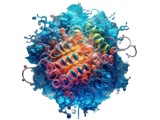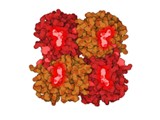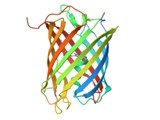Chromoproteins are colored proteins produced by various marine organisms, including corals and sea anemones. Unlike fluorescent proteins, they intensely absorb visible light, giving them vivid colors without needing excitation by ultraviolet light. These characteristics make chromoproteins promising candidates for various applications in biotechnology and synthetic biology.
Structure and Composition
Chromoproteins share a similar structure to fluorescent proteins, such as green fluorescent protein (GFP). They generally consist of eleven beta sheets forming a beta-barrel structure, inside of which lies a chromophore structured in an alpha-helix. This chromophore is often formed by an imidazolidine moiety resulting from the interaction of three specific amino acids.
The majority of chromoproteins adopt a tetrameric structure, which can enhance their thermal stability and intracellular longevity, thereby strengthening their photoprotective function against excessive light stress. However, this oligomerization can also lead to aggregation problems when overexpressed in heterologous systems, such as bacteria or mammalian cells, limiting recombinant protein production.
Mechanisms of Action and Biological Roles
Although the exact roles of chromoproteins in their host organisms are not fully understood, it is hypothesized that they play a photoprotective role, helping to protect tissues from damage caused by intense light. Additionally, they could serve as genetic markers in synthetic biology applications, due to their ability to provide visual detection without background fluorescence interference.
Applications in Biotechnology
Chromoproteins have found various applications, including:
- Genetic markers: Their ability to provide colored signals without background fluorescence makes them useful tools for tracking biological processes in cells.
- Photoacoustic imaging: As FRET (Förster resonance energy transfer) donors, chromoproteins can be used for advanced imaging applications, allowing better resolution and more precise detection of biological signals.
- Fusion protein development: Chromoproteins can be fused with other modules, such as carbohydrate-binding modules, to create functional proteins tailored for specific applications, such as textile functionalization.




